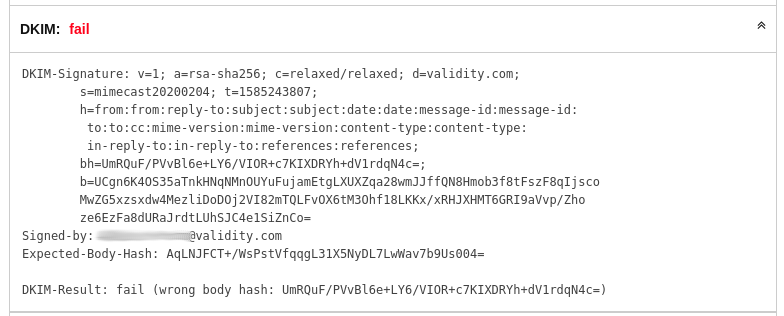An immense amount of 306.4 billion (306.400.000.000) e-mails will be sent in 2020 by only five different companies. Both the amount of e-mails and their market share grows every year, which is worrying. It means that smaller ESP's are pushed away, adding to the monopoly position of these five.
CoreSeeds
On March 10th 2020, I had a demo-call with a sales person from Validity Inc., at that time, they also used Return-Path as their name. The good man told me that Google, Microsoft, Yahoo, AOL and Verizon were sharing a virtual community, named CoreSeeds
. I guess E-mail Monopoly
was too obvious for a name. Today, Validity Inc. offers tools to give ESP's insights in deliverability (inbox placement) and other statistics. Microsoft agrees with Validity, since their documentation states you'll receive better inbox-placement if you have the Return-Path Certification.
To me, this Return-Path Certification
, sounded like you had to meet many technical requirements, perhaps even pass a test. At least something to actually verify you're sending valid e-mail. I was so eager to actually receive that Certificate, I'd probably even hang it on a wall. So I asked the man how to get certified, to learn all you had to do was to pass them your mailservers' ip-addresses and pay them the fee.
After some e-mails back and forth, the man finally dropped the bomb: $ 15-20k per year (their lowest tier), and the certificate would be mine. No further questions asked to get your spam — ahem, marketing e-mail — remote images and all, in any Microsoft Inbox. I must admit, the presentation was impressive, nice dashboards with lots of insights. Statistics only possible to have if there was at least some kind of cooperation with previously mentioned providers.
Make an educated guess…
You've probably guessed it, I didn't get the certification, but my e-mails do actually land in the inbox of Microsoft users (and others). How we achieve this?
Verification
You're probably familiar with techniques like SPF, DKIM and DMARC, the minimal required e-mail verification. These techniques are defined in RFC Standards
and published and maintained by the IETF. They're open standards anyone can — read: MUST — meet. They're the result of debates at M3AAWG, a non-profit with Anti-Abuse at it's core. Among M3AAWG's sponsors and members, you'll see, the same names as mentioned above. Same goes for IETF's members by the way.
Please don't get me wrong, I'm pro standards, even more when they're open and accessible for everyone. They improve e-mail security and make filtering spam a lot easier. Bad DKIM signature? Spam! Sending IP not in SPF? Spam! It's almost a watertight solution to detect bad messages. Almost, since our big friends don't really see them as that important. For example, when setting up e-mail on Office365, one should use DKIM, Microsoft says. Google Suite uses their signatures and make seting up your own optional, which is at least a lot better, but still doesn't meet requirements. And Validity Inc. fails miserably, or at least, judge for yourself.

These methods are no indication a message is good and can be fully trusted, but they can — when fully and properly implemented — provide a means of determining if a message is bad and therefore cannot be trusted. Then why aren't the creators using them properly and consistently? What does it tell us how they value these methods? It frustrates me greatly.
As a result, these verification methods serve as mere indicators for filtering spam. They require smart spam-detection rules and a well established reputation database to actually really fight spam. Isn't it a good thing Validity has that reputation data ready for you?
There's no such thing as a perfect Spam Filter
Our e-mail system has over 10.000 custom rules to fight Spam. And we're building our own reputation database in effort to reduce our current catch rate from 99,9% to 99,99%, or even higher.
Your data is safe with us…
In a 2018 article, written by Google's Director of Security, Trust & Privacy, Suzanne Frey explains your e-mails aren't actually read
by Google, they're only automatically processed
(except for very special cases). While this proves your mail isn't read by actual people, it does not disprove Google understands your messages' content. The fact that your e-mails are automatically separated into the Primary
, Social
, Promotions
, Updates
, etc. tabs, only confirms this.
The major problem is that most users of the above mentioned companies (and more) don't actually pay a dime to get premium service. The services are based on a freemium
model. From a business perspective, the free
part yields an issue: money. No money, no viable business, so they found a different way.
When a Product is free you're the product.
Your data — message content, behaviour, preferences, interests and more — is used to re-target you. The ads shown in search engines, social media, websites, even while using your webmail client, are targeted to you because your data proves you'll probably click. And the advertising party pays big time to get there. This makes the advertiser the actual client and you are merely the source of the data they sell.
Some might say that this isn't a problem for services like Google Workspace (aka Google Suite) or Office 365, because they're earning otherwise. I'd beg to differ, since why would they reinvent the wheel?
The value of E-mail Marketing
The 2016 Annual Email Marketing Report by Campaign Monitor states that every $1 spent on e-mail marketing, yields an average of $44 dollars in revenue. According to Statista's E-mail Marketing Spending, the US spent a total of $ 3,07 billion ($ 3.070.000.000) dollars in 2019. Simple math tells us we're talking about a $ 135,8 billion ($ 135.800.000.000) market in 2019, for the US only!
This translates to a lot of opportunity for all online marketeers, which is a good thing. With that kind of money, there must be share for everyone. Anybody saying E-mailmarketing is dead
, either never tried it or hasn't got a clue what they're talking about. Boy, is there money in the list!
A big market, in hands of the few. And this isn't even considering the regular B2B or B2C deals made using e-mail.
Conclusion: We need to fight!
E-mail was invented as an open standard, for everyone to use. It has seen a lot of changes over the years, improving security and reliability. But now, this open standard has been implemented, managed and taken over by only a few big companies.
We don't like the idea that these amounts of information are accessible to just a small number of companies, leaving them in force to do with it whatever they want. Therefore we've created the Perfacilis E-mail Service: Our own Enterprise E-mail Service, for everyone to use. No integration with Contact, Calendar or File Sharing apps — this is how you'll get data living everywhere — Just simple e-mail that works.
We know our service isn't free, it can't be. It would require us to sell your data, show obnoxious ads, or something else. We don't want that. We don't even collect your data. This is our fight against the big boys of this market, a hope to create a new standard for companies to earn an income with actually providing the best possible experience to their users.
Together we stand strong!
The more, the merrier. If you don't like it, we'll give you your money back no questions asked.
Sources
- E-mail Marketing in the US — Statista / Slideshare
- The Ultimate List of Marketing Spend Statistics for 2019 — Brafton
- Google says no one is reading your emails, except… — Mashable
- Comparison of webmail providers — Wikipedia
- The 10 Most Popular Email Providers in Germany — E-mail Migration Blog
